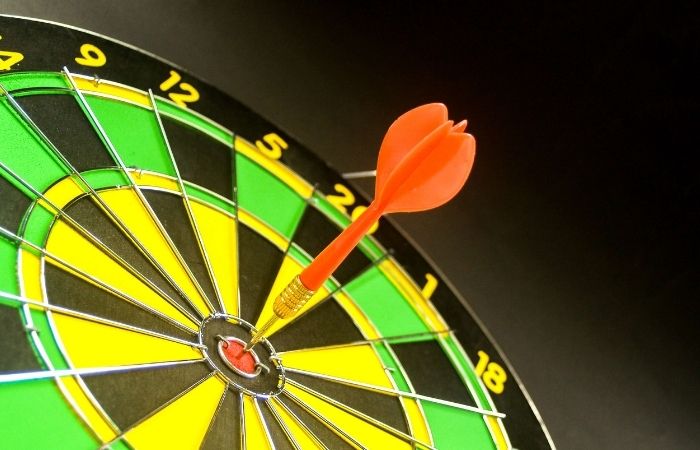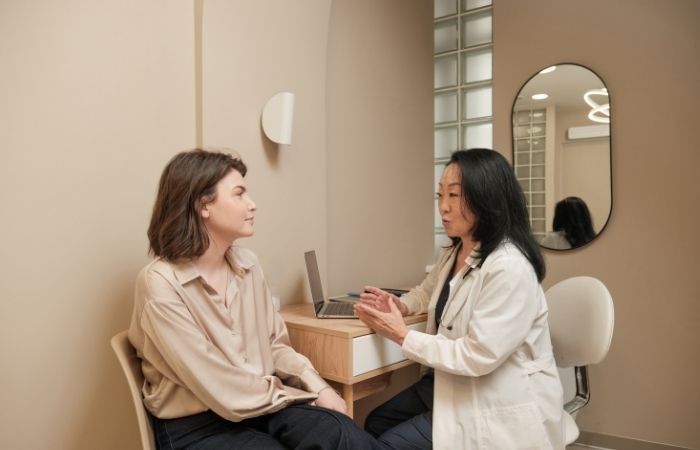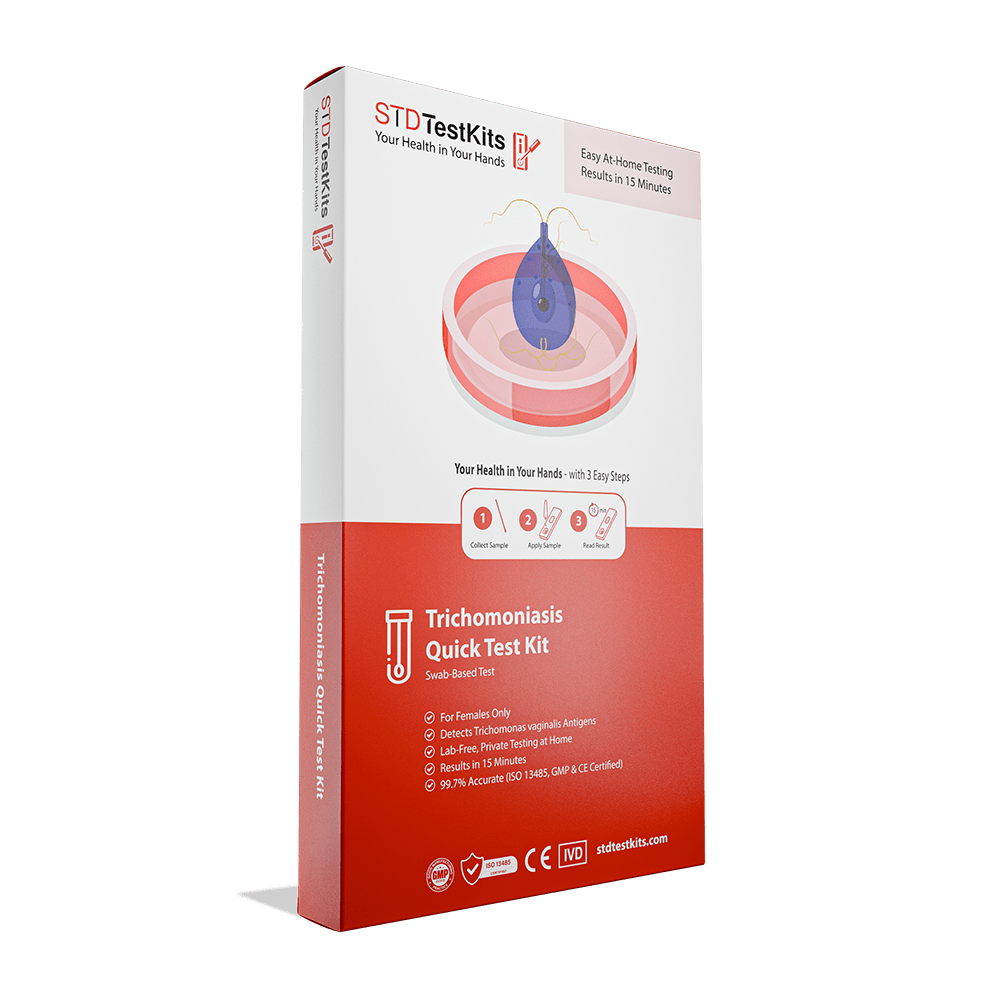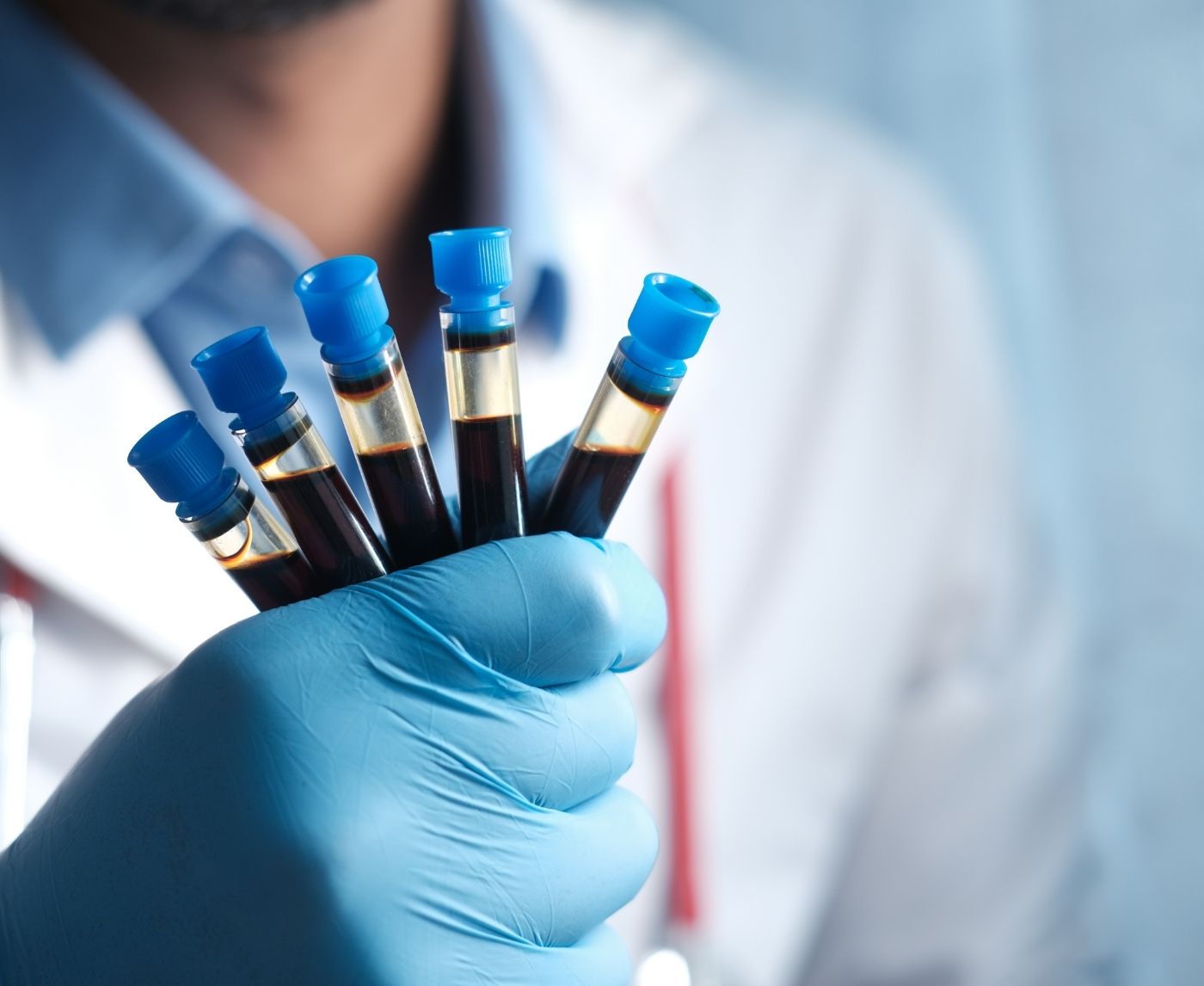How Soon After Sex Can You Test for HSV-1 or HSV-2?
Quick Answer: Trichomoniasis rapid tests are highly accurate when used after the window period, but faint lines can still appear and may indicate a weak positive. User error and testing too early are the top reasons for false negatives.
This Isn’t Just a Cheap Test, it’s a Complex Process
Most people assume that a rapid STD test works like a pregnancy test, one line negative, two lines positive. And while that’s partially true, the science behind detecting Trichomonas vaginalis is a bit more complex. These tests use lateral flow immunoassays to detect antigens from the parasite. Think of it like this: you’re testing for the parasite’s fingerprint, not the whole body. That means if the sample doesn’t capture enough of that fingerprint, or if you test before the infection is established, the test might miss it.
Trich tests typically use either a vaginal swab (for people with a vagina) or urine (more commonly used by people with penises). The sample is then applied to a cassette or test strip, which reacts chemically to the presence of trich antigens. If antigens are present in detectable levels, the test line appears, sometimes boldly, sometimes faintly. Faint doesn’t always mean false. In fact, a faint positive can still be a true positive, just at a lower antigen load.
What complicates things is the variability in how people collect and interpret their results at home. A quick swipe might not grab enough sample. Pee diluted with water from earlier in the day can muddy the accuracy. And that faint line you saw? It might fade, darken, or shift depending on humidity, lighting, or time elapsed.
Let’s Talk Numbers: How Accurate Is It, Really?
Rapid trichomoniasis tests aren’t guesswork. When used correctly and within the right window, they deliver impressive accuracy. But what exactly does that mean? Let’s break it down in plain terms.
Table 1. Rapid test performance estimates based on multiple peer-reviewed studies and manufacturer validations. Exact numbers vary slightly by test brand and sampling method.
To put this in perspective: if 100 people with trich take the test, it will correctly identify between 88 and 95 of them. The others may get false negatives, usually because they tested too early or didn’t collect enough sample. On the flip side, the chance of a false positive is low but not zero. A faint positive line in the right window period is more likely to be a true positive than a mistake, especially when symptoms are present.

People are also reading: Can You Get Chlamydia in Your Throat? Yes, Here’s What It Feels Like
Why the Window Period Can Make or Break Accuracy
Just like other STDs, trichomoniasis has a window period, that awkward waiting time after exposure when the infection may not show up on tests. For trich, this window typically lasts 5 to 28 days. Most people will test accurately around 7 to 14 days after exposure. But testing at day 3? You’re rolling the dice.
Let’s break it down through Tasha’s story. She had unprotected sex during a vacation weekend and started feeling “off” a few days later, some mild itching, no discharge. Anxious, she ordered an at-home rapid test and took it on day 4 post-exposure. It came back negative. A week later, the itching got worse and yellowish discharge started. She retested on day 12, and this time, the result was positive. That first test wasn’t wrong, it was too early. The parasite hadn’t shed enough antigen yet for the test to detect it.
The takeaway? Testing too soon may offer false comfort. Trich can be sneaky, especially in the early days. Your best shot at accuracy is waiting at least a week after exposure, and testing again around the two-week mark if your first test is negative but you’re still suspicious.
When a Line Isn’t a Line (But You Think It Might Be)
There’s nothing quite like the mental gymnastics of staring at a faint line on a rapid test cassette. You tilt it under better lighting, wipe your eyes, maybe even try another test. But the fact remains: the line is there, just barely.
Here’s the truth. Faint lines on trich tests are common. That’s because the intensity of the line is often proportional to the antigen load in your sample. If the parasite count is low, maybe due to early infection, partial treatment, or natural variation in shedding, you might still be infected even if the line isn’t bold. Manufacturers generally advise that any visible test line within the instructed read window (usually 10–20 minutes) should be considered a positive result.
It’s natural to want black-and-white answers, especially when your sex life, health, and relationships are on the line. But trich is a gray-zone kind of infection. Some people have raging symptoms and test faintly. Others have no symptoms at all and test boldly positive. The key is reading the test within the correct time window, usually between 10 and 15 minutes, and not past 20. Beyond that, evaporation lines can show up, making things even murkier.
The Most Common Mistakes People Make (And How to Avoid Them)
Rapid tests only work when every part of the process, from sample collection to timing to interpretation, is followed precisely. Unfortunately, many users are testing in private, under stress, or without proper lighting. That’s how small errors turn into false results.
Case in point: Malik, 24, did his trich test at 2AM after a hookup that left him itchy. He didn’t realize he needed to wait 30 minutes after peeing before collecting a sample. His test was negative, and he went about his week. By day six, he was leaking greenish fluid and feeling worse. The second test? Blazingly positive.
Here are the most frequent user-related issues that affect test accuracy:
Table 2. Common at-home testing mistakes that lead to unreliable results. These are preventable with careful preparation and attention to instructions.
Even something as simple as laying the test on an uneven surface or rushing through the sample dropper step can affect how the solution flows across the test strip. These are subtle actions, but in diagnostics, precision matters.
If you're unsure about whether you followed instructions correctly, or if the result doesn’t match your symptoms, it’s okay to retest. And if that second test still leaves you in limbo, confirmatory testing at a clinic may be the best next step.

People are also reading: He Didn’t Tell Me He Had Herpes, What Happened Next
Still Not Sure? Here’s When to Get a Confirmatory Test
Not every result demands a second opinion. But there are certain situations where getting a lab-based confirmation makes sense, and might even be critical. If your rapid test is faintly positive but you're symptom-free, or if you’re experiencing full-on discharge but your test is negative, that’s the time to loop in a clinician or lab.
Confirmatory testing for trich is typically done via NAAT (nucleic acid amplification test), which is considered the gold standard. These tests detect genetic material from the parasite and have even higher sensitivity than most rapid tests. The downside? They often require a visit to a clinic or a mail-in lab kit, and results can take several days.
So when should you confirm?
- When your rapid test result is unclear (e.g., very faint line, invalid result)
- When you’re symptomatic but test negative
- When you’ve had multiple sexual partners or known exposure
- When you're retesting after treatment and results are inconsistent
Remember, testing isn’t just about you, it also impacts your partners. That’s why confirmatory testing, especially before treatment or disclosure, can offer peace of mind and medical clarity.
This at-home combo test kit can screen for trich along with several other STDs, which is helpful if you’re unsure what’s causing symptoms or want full coverage in one go.
Retesting: When, Why, and What It Can Reveal
Retesting can feel like a hassle, but it’s often the missing link to real clarity. Trich can linger even after symptoms fade or treatment is completed. That’s because reinfection, especially from untreated partners, is extremely common. Studies suggest reinfection rates within three months can be as high as 20% in some populations.
If you’ve been treated for trich, you should wait at least 2–3 weeks before retesting. Testing too soon can pick up lingering antigens from dead organisms, resulting in a false positive. If you haven’t been treated but suspect an early false negative, wait a full 14 days and try again. Timing matters more than most people realize, and it’s the single biggest variable in whether your test gives you truth or confusion.
Think of testing as a snapshot. If the picture is blurry, take another one, but with better lighting, better prep, and better timing. That’s how you get closer to certainty.
“Am I Dirty?” and Other Thoughts That Don’t Belong Here
The hardest part of any STD test isn’t always the swab or the result, it’s the story we tell ourselves while waiting. Trichomoniasis, though common and treatable, still carries a heavy weight of shame. Especially because many people associate it with infidelity or “unclean” behavior.
But here’s the deal: anyone with genitals can get trich. It doesn’t mean you’re reckless, dirty, or broken. It means you’re human. In fact, the CDC estimates that nearly 2 million Americans have trichomoniasis, and most don’t even know it. Many infections happen in long-term relationships, with no cheating involved. Others are the result of condom slips, unspoken histories, or simple biology.
Take Jess and Morgan. Together three years. Jess started having weird discharge and burning during sex. The test was faintly positive. Morgan was shocked. “I didn’t cheat,” they said. And they hadn’t. After deeper testing, Morgan tested positive too, likely a low-level, asymptomatic infection from before they ever met. The couple treated it, had hard conversations, and moved forward. That’s the reality. Not drama. Just health care.
Testing positive is a medical fact, not a moral failure. If your test result is causing distress, take a breath. Then take action. You’re not the only one, and you don’t have to go through it alone.
FAQs
1. Can you have trich and feel totally fine?
Yep, and that’s what makes it so sneaky. About 7 out of 10 people with trichomoniasis don’t notice a single symptom. No weird smell, no discharge, nothing. You can pass it to someone else without ever knowing you had it. That’s why “I feel fine” isn’t a free pass, it’s a testing trap.
2. What does a faint line on a trich test really mean?
Think of it like a whisper instead of a shout. The test is trying to say “yes,” but not loudly. That faint line usually means there’s a small amount of trich antigen in your sample, likely a true positive. Don’t wait for it to darken like it’s a mood ring. If the line shows up within the time window, it counts.
3. How soon after sex can I test for trich?
Ideally? Wait at least 7 days. Earlier than that and you’re testing while the parasite is still setting up shop, it might not leave enough of a trace for the test to detect. If you test early and it’s negative, that’s not a forever answer. Give it another go at the two-week mark if symptoms pop up.
4. Is it possible for the test to be wrong?
No test is flawless, but trich rapid tests are impressively reliable when used right. Still, things like testing too early, old kits, or misreading results after the time limit can lead to confusion. If your result doesn’t match how you feel, or it just doesn’t make sense, retest or get a lab confirmation. You're not paranoid; you're being thorough.
5. Do I really need to retest after treatment?
Honestly, yes. Even if your symptoms vanish, there's still a chance of reinfection (especially if your partner wasn't treated). Retest 2–3 weeks after finishing meds. It's not overkill, it's protection. Your future self will thank you.
6. Can men carry trich and not know it?
Absolutely. Trich loves to hide out in people with penises. Most guys won’t feel a thing, no drip, no burn, no clue. But they can still pass it on. That’s why everyone, regardless of symptoms, should test after unprotected sex or if a partner tests positive.
7. I tested negative, but I still feel... off. What now?
You trust your gut for everything else, do the same here. It could be early infection, another STD like chlamydia or gonorrhea, or even something non-sexual like BV or a yeast imbalance. If your symptoms aren’t resolving, don’t wait for a test to catch up. Get checked again or try a broader panel.
8. Will trich just go away if I ignore it?
It might eventually clear on its own, but that’s a risky game. Trich that sticks around can increase your risk of HIV and cause complications in pregnancy. Treatment is simple and effective, usually just a single dose of antibiotics. Ghosting your STD is not the move.
9. Is it safe to have sex while I wait for results?
Emotionally? Maybe. Medically? Probably not. Until you know your status, and ideally until treatment is done and symptoms are gone, it’s best to hit pause or use protection. It’s not about punishment. It’s about care. For you and your partner(s).
10. Do I have to tell my partner if I test positive?
It's your call, but here's the truth: untreated trich just gets passed back and forth. If you’re planning to stay sexually active with that person, telling them is the most honest, and protective, thing you can do. If that conversation feels impossible, consider anonymous partner notification tools or text-based scripts. Shame doesn’t belong here. Honesty does.
You Deserve Answers, Not Assumptions
Testing at home can be a powerful act of self-care, when it works. But when results are murky, faint, or just don’t add up with what your body is telling you, it’s okay to ask more questions. False negatives happen. So do faint positives that feel unbelievable. What matters is what you do next.
Take your health seriously without taking on unnecessary shame. If your result confused you, retest with better timing, better prep, or a better understanding. And if you want broad coverage for peace of mind, a combo kit might be your best next move.
Don’t wait and wonder, get the clarity you deserve. This at-home combo test kit checks for the most common STDs discreetly and quickly.
How We Sourced This Article: We combined current guidance from leading medical organizations with peer-reviewed research and lived-experience reporting to make this guide practical, compassionate, and accurate.
Sources
1. Rapid and Point-of-Care Tests
3. Use of an Immunochromatographic Assay for Rapid Detection
4. Optimal Timing for Trichomonas Test of Cure Using NAAT
5. World Health Organization – STIs Overview
6. Planned Parenthood – Trichomoniasis Overview
About the Author
Dr. F. David, MD is a board-certified infectious disease specialist focused on STI prevention, diagnosis, and treatment. He blends clinical precision with a no-nonsense, sex-positive approach and is committed to expanding access for readers in both urban and off-grid settings.
Reviewed by: Jasmine M. Tello, NP-C | Last medically reviewed: October 2025
This article is just for information and should not be used as medical advice.







